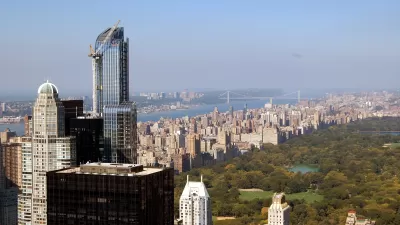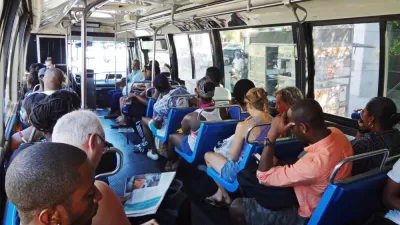For all those cities that double population during the work day, here's a revenue thought to consider. But why restrict it to in-bound commuters? What about residents who commute-out of the city? Is the commuter tax a legitimate revenue source?
While "New York City’s commuter tax expired more than a decade ago, political arguments for its revival continue to persist, as recently as last year’s mayoral election," writes Mike Maciag, data editor for Governing. But this revenue option is not limited to big cities.
"Last week, officials in Johnstown, Pa., which participates in a state program for distressed cities, told a panel of judges that they either needed to implement a commuter tax or scale back services. In Indiana, state legislators are mulling their own commuter tax for counties."
However, cities with the highest percentages of nonresident commuters in their workforce may not be what you think they are. See quiz questions below.
And the commuter tax need not be restricted to the conventional commuter. There could also be a "reverse commuter tax". Distressed areas could consider a related revenue stream for their residents who commute the opposite direction.
Buried deep in Detroit Emergency Manger Kevyn Orr’s restructuring plan released last month was a single line that caught the attention of one group of taxpayers. For the first time, the city publicly stated it was weighing an ordinance requiring employers to withhold city income taxes for reverse commuters.
So job-rich areas might tax non-residents who commute in, and job-poor cities could tax residents who commute out. However, it's the conventional commute tax that is considered the most "as property tax bases dwindle," writes Maciag. "Taken together, these two groups of taxpayers represent a largely untapped source of potential revenue that cities may begin to target more aggressively, particularly if they’re struggling."
Readers might wish to view "Governing's compiled data published for the Census Bureau’s American Community Survey to compute localities’ estimated nonresident workers. Across all cities with at least 50,000 workers, nonresidents accounted for slightly more than half – 52 percent – of the total workforce."
However, note that areas need not be incorportated, as is the case for the one in Fairfax County, Virginia, population 19,627, with the highest percentage of nonresident workers: 91.6%. Guesses anyone?
And here's a surprise - for me, anyway. Guess which cities in New York State had the highest and the lowest percentages of nonresidents in their workforce?
- White Plains
- Albany
- Rochester
- Syracuse
- Buffalo
- Yonkers
- New York
(Answer: It's numbered in descending order. New York City had 21.5%; White Plains, 81.2%)
FULL STORY: Cities Consider Taxing Commuters to Drive Up Revenue

Alabama: Trump Terminates Settlements for Black Communities Harmed By Raw Sewage
Trump deemed the landmark civil rights agreement “illegal DEI and environmental justice policy.”

Study: Maui’s Plan to Convert Vacation Rentals to Long-Term Housing Could Cause Nearly $1 Billion Economic Loss
The plan would reduce visitor accommodation by 25% resulting in 1,900 jobs lost.

Why Should We Subsidize Public Transportation?
Many public transit agencies face financial stress due to rising costs, declining fare revenue, and declining subsidies. Transit advocates must provide a strong business case for increasing public transit funding.

Wind Energy on the Rise Despite Federal Policy Reversal
The Trump administration is revoking federal support for renewable energy, but demand for new projects continues unabated.

Passengers Flock to Caltrain After Electrification
The new electric trains are running faster and more reliably, leading to strong ridership growth on the Bay Area rail system.

Texas Churches Rally Behind ‘Yes in God’s Back Yard’ Legislation
Religious leaders want the state to reduce zoning regulations to streamline leasing church-owned land to housing developers.
Urban Design for Planners 1: Software Tools
This six-course series explores essential urban design concepts using open source software and equips planners with the tools they need to participate fully in the urban design process.
Planning for Universal Design
Learn the tools for implementing Universal Design in planning regulations.
Caltrans
Smith Gee Studio
Institute for Housing and Urban Development Studies (IHS)
City of Grandview
Harvard GSD Executive Education
Toledo-Lucas County Plan Commissions
Salt Lake City
NYU Wagner Graduate School of Public Service





























